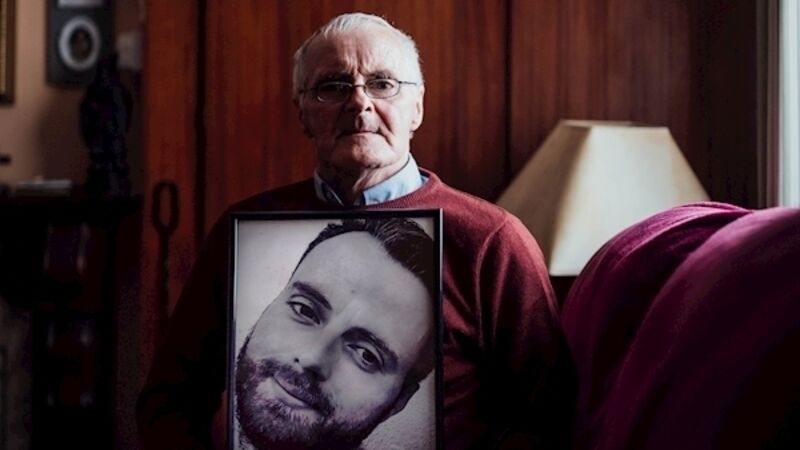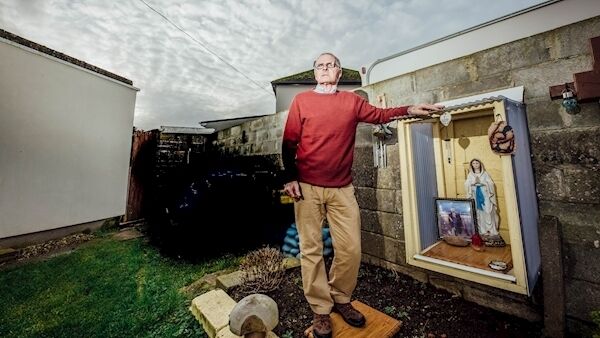Michael Clifford: A young man’s death in custody

Sean Hayes Barrett was remanded to Limerick prison hours after being released from psychiatric hospital. He wasn’t observed properly and his state of mind deteriorated, says
At 4.15am on May 6, 2017, the Darkness Into Light Run got underway at various centres across the State.
The run is an annual event to highlight suicide. Seven minutes earlier, a prison officer checked in on Sean Hayes Barrett in his cell in Limerick prison.
Mr Hayes Barrett had been held in the prison for the previous seven days. He had never been in prison before. He had never been convicted of a crime. He was alone in his cell.
Over the previous week he had grown increasingly isolated in an alien environment, denied access to loved ones and to recently prescribed medicine designed to help him with suicidal ideation.
In a telephone conversation with his girlfriend three days into his incarceration, he sounded desperate.
“It’s too hard,” he said. “I’m not able for the isolation. The isolation is too hard on me.”
At 5.07am, when the Darkness into Light run was underway, a prison officer found Sean Hayes Barrett in his cell with a ligature around his neck. He was a 31-year-old vulnerable man who had encountered serious mental health issues only in the last months of his life.
There is evidence that his death was entirely avoidable, that circumstance and a blatant dereliction of duty on the part of the State culminated with him taking his own life.
His father, Sean Barrett, says he will never get over how his son died.
I reared him on my own in that house,” he says. “All those years and then he’s gone forever. Sean was my life. I’m on my own now. There will never be no closure for me. How can there be?
Sean Hayes Barrett is remembered by his father as a quiet boy. “He had a couple of friends, he was into football and Taekwondo,” Sean Snr says.
After school, Sean got a succession of jobs in Limerick city, where he was reared. He visited his father every week.
“He’d come on a Saturday,” Sean says. “He’d come with his girlfriend and she’d often go home at some stage while me and Sean just sat there talking for hours.”
In the year running up to his death Sean was living with his girlfriend in an apartment in Limerick city. The Irish Examiner has contacted this woman but she says she does not wish to speak about Sean or the circumstances around his death.
The official record shows that this woman repeatedly attempted to get the proper care for Sean, and to visit him, in the last week of his life.
Sean Snr also looked after his son’s two dogs because it was not possible to house them in the apartment.
“He loved those dogs,” Sean says. “He led a simple life, never did anything wrong to anybody.”
Early in 2017, Sean failed to show up at his father’s house for four weeks running. “I was surprised, but I let it go for a few weeks,” he says.
“Then I phoned and his girlfriend wouldn’t tell me anything. She’s a good person but it looked as if Sean had some secret that he didn’t want to tell. Afterwards she told me that he didn’t want to burden me with it.”
Up until that point Sean had never displayed signs of mental health difficulties. He was quiet and unobtrusive, was in a relationship and had no history of any psychiatric problems.
In late March, he was admitted to the psychiatric unit in Limerick University Hospital. The mental health difficulties he began to encounter included suicidal ideation. The extent of these difficulties required him to remain in the psychiatric unit, known as 5B, for five weeks.
He left the hospital on April 29. Venturing back out into the world he was armed with medication to assist him with the suicidal ideation, a prescription for a refill and a letter of appointment with a psychiatrist for May 4. His father was unaware that he had been in hospital.
On the day of his departure from hospital Sean was arrested after a minor altercation with a woman in a city centre store. He told the gardaí that if he was free he would commit crimes of a sexual nature. The gardaí who interviewed him were concerned about his mental health.
That afternoon he was brought before Kilmallock District Court. Judge Marian O’Leary was told that gardaí were objecting to bail on the basis of the threat to commit crime that Sean had made.
The main thrust of the hearing was concern for Sean’s mental health and whether he was a danger to himself or others. The judge remanded him to Limerick prison. Both the prosecuting garda and the defence solicitor appointed on the day told the court they would each contact Limerick prison to alert staff to Sean’s condition.
Remand to prison of people with obvious mental health problems is not unusual but highly controversial. In reality, judges often have little option as there is a chronic lack of beds in secure psychiatric units.

There is no secure unit in Limerick. The only option open would be to locate a bed in the Central Mental Hospital in Dundrum, Dublin. A decision in that regard would be a matter for the prison authorities.
“Why wasn’t Sean sent to hospital if they weren’t going to release him,” his father says.
“He should have been in hospital. He should never have been in prison. He was never in prison before in his life.”
The Irish Penal Reform Trust has repeatedly stated that prisons should not be used to hold individuals with mental health difficulties.
“The prison places such persons at risk of developing further, or deeper, problems connected to placement in inappropriate conditions,” according to a briefing document from the trust.
“It does not provide them with appropriate therapeutic interventions; it places them at greater risk of self-harm and suicide.”
Sean Hayes Barrett was admitted to Limerick prison at 5.25pm on Saturday, April 29.
On entry, his medication, prescription and record of appointment with a psychiatrist were taken from him. These items were not recorded with his other possessions.
An investigation by the Inspector of Prisons found no evidence that the nursing staff were informed by officers at the main prison gate that Sean had medicine and medical records in his possession.
Both the solicitor and the prosecuting garda contacted the prison as they had told the court they would do. These contacts were not made known to the Inspector of Prisons in the subsequent investigation nor did they feature in the inquest into Sean’s death.
On the day he was admitted Sean was interviewed by a nurse who recorded that she “advised (Sean) his medication did not arrive with him…he will have to go see a GP.”
This was effectively referring him to a doctor to determine whether he required any medicine, despite the medicine he was already prescribed having been taken from him in the prison.
Following the interview, he was placed under “special observation”. This is a category of prisoner deemed to be vulnerable.
He was housed in a two-person cell on his own. Whatever the reasons for this, it increased his sense of isolation. There are two dedicated psychiatric cells in the prison but it is unclear why he was not referred there. Most likely this was due to capacity issues.
Sean went two days without receiving his medication. He phoned his girlfriend on the day after his admission, and every subsequent day. She attempted to get an appointment to visit him.
Every prisoner on remand is entitled to a daily visit of not less than 15 minutes, yet Sean’s girlfriend “found it extremely difficult to make an appointment”, according to the inspector’s report.
Eventually, she was given an appointment for May 8 which would have been nine days into Sean’s imprisonment had he lived. The failure to allow his close friend visit him, combined with being alone in his cell, could only have heightened his sense of isolation.
During their phone conversation on May 1 he told his girlfriend he had not yet received his medication. She contacted the hospital and was told that prison staff had been provided with details of his medication.
The Inspector of Prisons found that he was administered the medicine on the evening on May 1 and every day thereafter.
On May 2, during a conversation with his girlfriend Sean said that he had received his medication the previous night but he didn’t think it was his normal dose. This was also the call on which he told her that “the isolation is too hard on me.”
As a remand prisoner he would have been spending 23 hours daily alone in his cell.
Sean’s father was finally told that he was in prison on May 4. He was told that Sean would be appearing in court for a remand hearing the following day.
I arranged to go to the court with my sister but in the end she couldn’t go and by the time I got there he’d been taken away in the van.
Sean Snr then made attempts to arrange for a visit.
That evening at 8.09pm Sean was given his medication by a nurse and locked up for the night in his cell.
As a special observation prisoner, he should have been checked in on every 15 minutes during lock-up. This is designed to minimise the possibility of self harm in particular.
During the night, Sean should have been subjected to 39 checks under this rule. In fact, he was only checked nine times, with the intervals between checks varying from 28 minutes, to, in the worst case, two hours and fifty four minutes.
The failure to properly check special observation prisoners has been a feature of investigations following a number of deaths in custody in Irish prisons.
In this case, the governor of Limerick prison, Mark Kennedy, told the Inspector of Prisons that an incident occurred on the night in question in another part of the prison which required the deployment of extra prison officers.
This incident persisted for two hours and meant there were fewer officers available to check on special observation prisoners.
The Irish Prison Service has a policy that allows for extra officers to be called into the prison in the event of an incident arising. No call was made to any off-duty officers on the night in question.
Sean Hayes Barrett was checked at intervals that averaged around an hour through the night.
A prison officer looked in on him at 2.54am. The next check was at 4.08am. Fifty four minutes later an officer looked in and saw Sean with a ligature around his neck.
Efforts to resuscitate him were unsuccessful. He was pronounced dead at 7am on 6 May 2017.
The CCTV footage for the night/morning of May 5/6 went missing within the prison system. This failure to retain footage from a period prior to a death in custody had happened on a number of occasions and has been the subject of criticism from successive inspectors.
In this case, a chief officer was “commended for his diligence in making the written record of the CCTV footage”.
At the inquest into Sean’s death last December, his father’s solicitor Jerry Twomey of Frances Twomey Solicitors, questioned governor Kennedy on a number of issues that arose. The governor agreed that prison officers were not aware that Sean was a special observation prisoner.
“We weren’t 100% that the officers on the night got the up to date special obs list,” Mr Kennedy said.
The governor also agreed that despite the incident that happened in the prison on the night nobody made the call to draft in extra staff in order to cover the special observation prisoners.
“We didn’t abide by our own protocols,” Mr Kennedy said. “Our own protocols were that he needed to be checked every 15 minutes and that didn’t happen. It is fair to say that this case was a landmark case and, as a result of Sean’s death the whole system has changed throughout the prison service.”
Significantly, coroner John McNamara recorded an open verdict in the case.
He said that under the European Convention on Human Rights the State had a positive duty to prevent deaths where possible and “it appears to me there were systems failures in respect of Seay Hayes’s incarceration.”
He said the nature of Sean’s death “on the face of it would imply that it was a suicide”, but taking the system's failures into account he was not happy to record a verdict of suicide.
The family was pleased with the outcome.
“We appealed for open verdict and family is very satisfied that that is what the coroner found,” Jerry Twomey told the Irish Examiner.
“There were a number of different failures. Sean’s girlfriend tried on a number of times to visit him. He was deprived of medication and access to loved ones.
We don’t even know whether he got the hour of exercise daily to which he was entitled. And on the night it happened there was this other incident which meant he was not checked as per the regulations, but no extra staff were called in.
"How overwhelmed could they have been?”
For Sean Barrett, the failures that led to his son’s death are matters he says he will never be able to fully comprehend.
“I’ll be hurt forever,” he says. “I visit Sean’s grave three times a week now. My sister’s husband brings me in the car because it’s six miles away. That’s my life now.”















